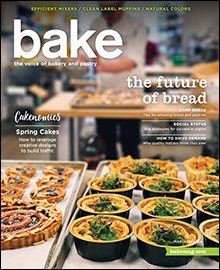 |
Rye flour makes a sticky dough that is difficult to handle, so bread baker Mark Furstenberg recommends baking this in a Dutch oven or baking cloche (a clay pot with a domed lid) rather than shaping the dough into a long loaf. It bakes beautifully that way and comes out of the casserole with a thick, chewy crust.
Ingredients
For the rye sponge/starter
46 grams rye flour, such as Arrowhead Mills brand (1/3 cup)
54 grams water (1/4 cup)
1 gram instant yeast, such as Fleischmann’s Rapid Rise (about 1/3 teaspoon)
1/2 medium onion, cut into 2 pieces
For the dough
100 grams white bread flour (slightly more than 1/2 cup)
350 grams rye flour, such as Arrowhead Mills brand (slightly more than 2 cups)
Rye sponge/starter (see above; about 1/2 cup)
300 grams water (1 1/3 cups)
5 grams instant yeast, such as Fleischmann’s Rapid Rise (about 1 1/2 teaspoons)
13 grams fine sea salt (2 teaspoons)
10 grams caraway seeds (1 tablespoon)
1 tablespoon cornstarch, for brushing the dough
1/4 cup water, for brushing the dough
Rolled oats, for dusting the bread-baking pot (Dutch oven)
Directions
For the rye sponge/starter: Combine the rye flour, water and yeast in a medium mixing bowl; stir just to combine, then add the onion. Cover the bowl tightly with plastic wrap and let sit at room temperature. Left at room temperature, the sponge can be ready in a minimum of 8 hours and up to 12 hours. Bubbles should start to form in about 4 hours. Or cover and let sit for 1 hour at room temperature, and then refrigerate for at least 12 hours or later use. But you will have to add a bit of flour and water if refrigerated for more than 1 day. (If refrigerated, bring to room temperature before adding to the dough. After a number of days, it will sour.)
For the dough: Remove the onion from the sponge and discard it. Combine the sponge, flours and 300 grams of water in the bowl of a stand mixer fitted with a dough hook attachment; beat on low speed for 3 to 4 minutes. Add the yeast, salt and caraway seeds; beat on low speed for 6 minutes. Transfer to the prepared bowl, cover with plastic wrap so that the wrap does not touch the dough and let sit at room temperature for 1 hour. The dough should look like a thick batter with lots of different-size bubbles. (If refrigerating, it may be necessary to let the chilled dough come to room temperature so its bubbles can emerge.)
Spray the work surface with nonstick cooking oil spray and pour the dough onto the prepared surface. Use a wet plastic scraper or wet hands to lift the edges of the dough from the work surface and fold them into the center of the mass of dough. Repeat 4 to 6 times, slightly rotating the dough as you work to keep it from sticking to the work surface. Wet your hands often.
Place the dough in the prepared bowl; cover with a clean dish towel, being careful not to let it touch the dough. Let it sit at room temperature for 45 minutes to 1 hour or until the dough has increased in size but not doubled. The dough’s texture should look lighter. About 30 minutes before the dough is finished proofing, preheat the oven to 450 degrees. Ten minutes before the bread is to be baked, heat a medium-size (4-quart) Dutch oven with its lid on. (The dough should fill the Dutch oven about halfway.)
When ready to bake the bread, combine the cornstarch and 1/4 cup water in a cup, stirring to dissolve. Working quickly, transfer the Dutch oven to the stovetop (off the heat). Sprinkle the bottom of the heated Dutch oven with rolled oats to keep the bread from sticking. Turn the dough into the hot pot. Brush the cornstarch mixture on the top of the dough, then use a lame to make several quick, clean strokes, about 1/2 inch deep. Re-cover and place in the oven; reduce the heat immediately to 375 degrees. After 25 to 30 minutes, check the look of the bread; it should begin to pick up color. Remove the lid and bake for about 10 minutes, until the loaf looks quite brown. The bread will be done when tapping your fingers on the bottom of the loaf produces a clearly hollow sound. Transfer the loaf to a wire rack to cool for at least 1 hour.
Formulation courtesy of Mark Furstenberg



